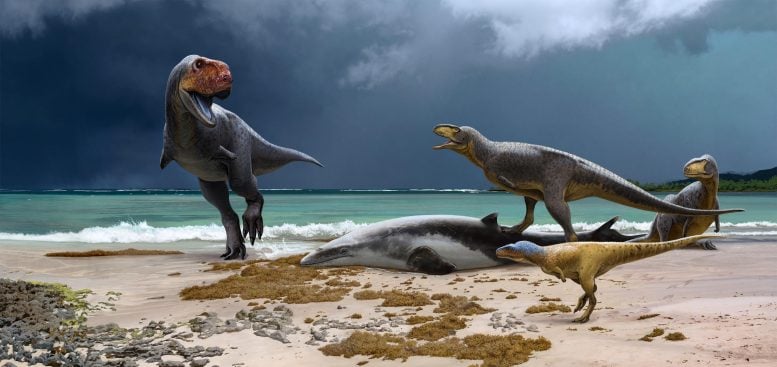
Scientists discovered fossils of two new dinosaur species in Morocco, revealing that diverse carnivorous species lived there just before the asteroid-induced extinction event 66 million years ago. Contrary to some beliefs that dinosaurs were already declining, these findings suggest they were thriving in North Africa until their abrupt end. Credit: Andrey Atuchin
Scientists in Morocco have uncovered fossils of primitive cousins of T. rex that had short, bulldog snouts and even shorter arms have been discovered by scientists in Morocco. These two newly identified dinosaur species are members of the Abelisauridae family, which were the carnivorous counterparts to the Northern Hemisphere’s tyrannosaurs. Existing during the final stages of the Cretaceous period, these discoveries underscore the rich diversity of dinosaurs in Africa right before an asteroid led to their widespread extinction 66 million years ago.
Two new species of dinosaur have been found from the end of the Cretaceous in Morocco, just outside of Casablanca. One species, found near the town of Sidi Daoui, is represented by a foot bone from a predator about two and a half meters (eight feet) long. The other, from nearby Sidi Chennane, is the shin bone of a carnivore that grew to around five meters (15 feet) in length.
Both were part of a family of primitive carnivorous dinosaurs known as abelisaurs and lived alongside the much larger abelisaur Chenanisaurus barbaricus, showing that Morocco was home to diverse dinosaur species just before a giant asteroid struck at the end of the Cretaceous, ending the age of dinosaurs.
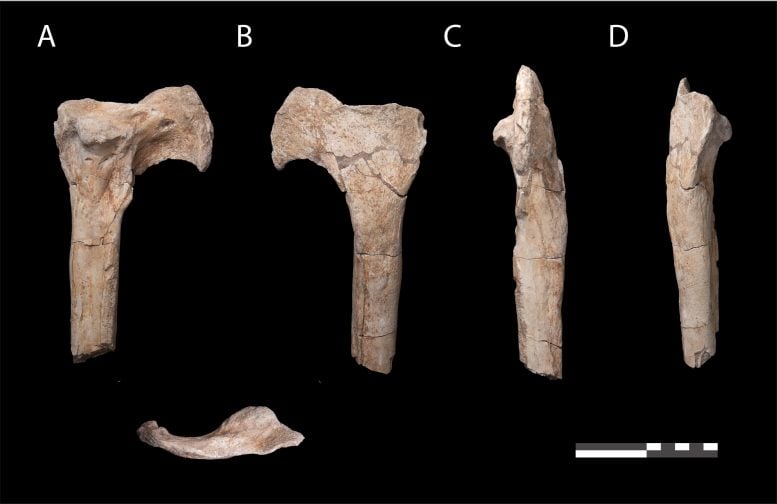
Fossil abelisaur tibia. Credit: University of Bath
Dr Nick Longrich, from the Milner Centre for Evolution at the University of Bath, led the study. He said: “What’s surprising here is that these are marine beds.
“It’s a shallow, tropical sea full of plesiosaurs, mosasaurs, and sharks. It’s not exactly a place you’d expect to find a lot of dinosaurs. But we’re finding them.”
Even though dinosaurs account for a small proportion of the fossils, the region is so rich in fossils, it has produced the best picture of African dinosaurs from the end of the age of dinosaurs. Rather than finding the same few species, paleontologists often recover fossils from new species, suggesting the beds host an extremely diverse dinosaur fauna.
So far, the small number of dinosaur fossils that have been recovered represent five different species – a small duckbill dinosaur named Ajnabia, a long-necked titanosaur, the giant abelisaur Chenanisaurus, and now the two new abelisaurs.
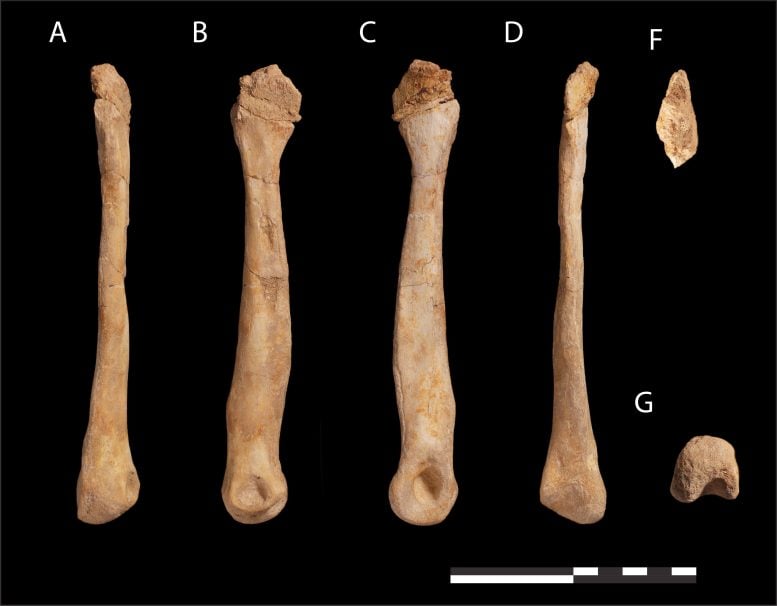
Fossil abelisaur metatarsal. Credit: Nick Longrich, University of Bath
Dr Longrich said: “We have other fossils as well, but they’re currently under study. So we can’t say much about them at the moment, except that this was an amazingly diverse dinosaur fauna.”
The last dinosaurs vanished around 66 million years ago, along with as much as 90% of all species on earth, including mosasaurs, plesiosaurs, pterosaurs and ammonites. The pattern of the end-Cretaceous extinction and its causes have been debated for over two hundred years. A giant asteroid impact in the Yucatan peninsula has been linked to their demise, although it’s been argued that dinosaurs were already in decline. The Moroccan dinosaurs suggest that they thrived in North Africa up to the very end.
“The end of the Cretaceous in western North America definitely seems to become less diverse at the end,” said Longrich. “But that’s just one small part of the world. It’s not clear that you can generalize from the dinosaurs of Wyoming and Montana to the whole world.
“It also grew colder near the end, so it might not be surprising if dinosaurs at higher latitudes became less diverse. But we don’t know much about dinosaurs from lower latitudes.”
In Morocco at least, they seem to have remained diverse and successful up until the end.
“When T. rex reigned as a mega predator in North America, abelisaurs sat at the top of the food chains in North Africa,” said Nour-Eddine Jalil, a professor at the Natural History Museum and a researcher at Universite Cadi Ayyad in Morocco, who was a co-author on the paper.
“The dinosaur remains, despite their rarity, give the same messages as the more abundant marine reptile remains.
“They tell us that, just before the Cretaceous-Paleogene crisis, biodiversity was not declining but on the contrary, was diverse.”
Reference: “New fossils of Abelisauridae (Dinosauria: Theropoda) from the upper Maastrichtian of Morocco, North Africa” by Nicholas R. Longrich, Erik Isasmendi, Xabier Pereda-Suberbiola and Nour-Eddine Jalil, 22 August 2023, Cretaceous Research.
DOI: 10.1016/j.cretres.2023.105677

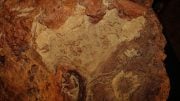
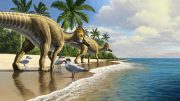
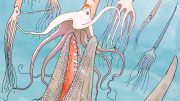

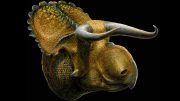
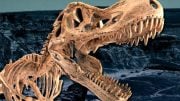
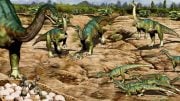
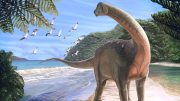
It’s not primitive cousins of t.rex the better dinosaur for that ceratosaurus .t.rex is a tetanuran dinosaur like gator compsognathus . The age of dinosaur is still continue in Africa the Nile crocodile dwarf crocodile still live there and they are tyrannosaur like spinosaurus the extinction is one science view .and cold is not problem for American gator in survive in arctic weather it’s a native of North Carolina were they see that type of weather
Alligator can survive in New York they were a feral gator live in Pennsylvania for many winters .one dwarf caiman live in the mountain in very ice run off river and can hunt in cold waters .dinosaur is so popular with myth in main stream news media clearly dinosaur is most corrupt animal ever .modern crocodilian can survive in Canada they were a fossil of won of them on a island and will not have a problem live in europe I saw dumb story on YouTube on invasive species cliam they will died they clearly know nothing about modern crocodilian .dinosaur time is sub tropical clearly Pennsylvania is not sub tropical.
South Africa nile crocodile is known to take the cold it is cold in South Africa .won of modern crocodilian I miss is a cold species that the nile crocodilian from Egyptian it’s a desert crocodilian in the desert it is cold at night I know because cats are from desert so they must design for extreme heat and cold at night the night in the desert is much colder in summer than New York that desert weather that why cat can live in most places .probaly too cold for a reptile the nile crocodile is well design night hunter it has cat eyes that glow reptile hate the night this is a colder night .allso has modern crocodilian species name desert crocodile .that is reason they can live in South Africa they say American crocodile have tough time in Miami some even die this is probaly deevolution or one die year that mean nothing and it kill a million animal at night .and they have people dive with nile crocodle in the winter a very dangerous education myth they here .this probaly was a South Africa nile crocodile the crocodile probaly was not hungry .i guest no won knows how much cold modern crocodile can take they say all modern crocodilian came from the nile crocodile all lack the fourth toe claw and epipygoid.as for nile crocodile population some say it’s high some say it’s low but clearly dwarf crocodile is low people eating them why would you want to eat a dinosaur .man is only problem for modern crocodilian they are the most successful dinosaur .about million gator in Florida .gator can take cold very well can survive frozen pond .spectacled caiman is not from a cold place they are invasive species in Florida .the Miami is very warm sub tropical almost tropical some reptiles do not like it there because it too cold there .most reptile are tropical species 70s 60s are too much for them .the spectacled caiman looks like they give up to get rid of them in Florida they say it’s hard to get rid them .the other myth dinosaur
That crocodilian is not bipedal the scientific report say they can it is 1983 the link stance and gait of the theropod dinosaur.you can see the gharial bipedal on YouTube sawtooth crocodile walking like dinosaur
Stance and gait of the theropod dinosaur=stance and gait in theropod dinosaurs